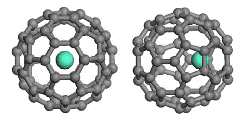Department of Chemistry
Date of this Version
3-1-2007
Abstract
The discovery of the unique catalytic effects of gold nanoparticles on oxide substrates[1] has stimulated a flurry of research into the structures and properties of free gold nanoclusters, which may hold the key to elucidating the catalytic mechanisms of supported gold clusters. One of the most remarkable results has been the discovery of planar gold cluster anions (Aun-) of up to twelve gold atoms and the 2D to 3D transition for clusters with n larger than 12.[2]– [4] Among larger gold clusters, Au20 has been found to be a perfect tetrahedron.[5] A more recent study of the structures of Aun- cluster anions in the medium size range (n=15–19)[6] has shown that clusters with n=16–18 possess unprecedented empty cage structures. In particular, the Au Au16- cluster anion has an interesting tetrahedral structure with an inner diameter of about 5.5 Å and can be compared to the fullerenes (buckyballs). Although Au32 was first suggested to be a “24-carat golden fullerene,”[7], [8] subsequent studies showed that the Au32- ion is in fact a low-symmetry compact 3D structure.[9] Other larger gold cage clusters have also been proposed computationally,[ 10], [11] but none has been observed or is expected to be the global minimum. The cage structures of the cluster anions Au16- and Au17- have recently been confirmed by electron diffraction[12] and thus they are the first experimentally confirmed and the smallest possible gold cages. The large empty space inside these cage clusters immediately suggested that they can be doped with a foreign atom to produce a new class of endohedral gold cages[6] analogous to endohedral fullerenes.


Comments
Published in Angewandte Chemie International Edition 46:16 (2007), Pages 2915–2918; doi 10.1002/anie.200700060 http://www.angewandte.org Copyright © 2007 WILEY-VCH Verlag GmbH & Co. KGaA, Weinheim. Used by permission.